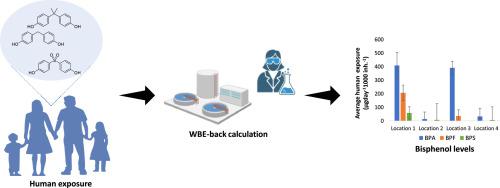当前位置:
X-MOL 学术
›
Water Res.
›
论文详情
Our official English website, www.x-mol.net, welcomes your
feedback! (Note: you will need to create a separate account there.)
Wastewater-based epidemiology methodology to investigate human exposure to bisphenol A, bisphenol F and bisphenol S.
Water Research ( IF 11.4 ) Pub Date : 2024-06-28 , DOI: 10.1016/j.watres.2024.122016 Andrea Estévez-Danta 1 , Rosa Montes 1 , Ailette Prieto 2 , Miguel M Santos 3 , Gorka Orive 4 , Unax Lertxundi 5 , José Benito Quintana 1 , Rosario Rodil 1
Water Research ( IF 11.4 ) Pub Date : 2024-06-28 , DOI: 10.1016/j.watres.2024.122016 Andrea Estévez-Danta 1 , Rosa Montes 1 , Ailette Prieto 2 , Miguel M Santos 3 , Gorka Orive 4 , Unax Lertxundi 5 , José Benito Quintana 1 , Rosario Rodil 1
Affiliation

|
Wastewater-based epidemiology (WBE) has become an invaluable tool for tracking the evolution of use or exposure of/to numerous substances. Bisphenols, commonly utilized in manufacturing plastic goods, have been categorized as endocrine disrupting chemicals, underscoring the critical need for real-time data on their local-level exposure to safeguard public health. In this study, we have developed a novel analytical method and WBE framework for the assessment of population-level exposure to bisphenol A (BPA) and its most prominent substitutes, bisphenols F and S (BPF and BPS), through the determination their Phase II metabolites in wastewater by WBE. Stability and exclusivity tests denoted that glucuronides are not stable in sewage, whereas sulfate metabolites are good biomarkers. Therefore, a solid-phase extraction followed by liquid chromatography-tandem mass spectrometry method was developed for the bisphenols’ monosulfates and BPA bissulfate. The analytical method was validated with three different wastewater matrices, providing trueness (as recovery) in the 79–112 % range with relative standard deviations < 12 %, and method quantification limits below 2 ng L−1 for monosulfates, but higher (35 ng L−1 ) for BPA bissulfate. Subsequently, the method was applied to 24h-composite raw wastewater samples collected over a week in 4 different locations in Spain and Portugal. BPA bissulfate was not detected, but the three monosulfate metabolites of each bisphenol were positively detected in the samples, being the metabolite of BPA the most prevalent, followed by those of BPF and BPS. Community-wide BPA intake was then estimated to be higher than the European Food Safety Agency (EFSA) tolerable daily intake (TDI) of 2 × 10−4 µg kg−1 day−1 in all locations. In the case of BPF and BPS, there is not enough metabolism data or even established limit, but they would also surpass safe levels in several locations if a similar metabolism and TDI would be assumed. This innovative method could be used to a larger set of wastewater-treatment plants as an early-warning approach on human exposure to bisphenols.
中文翻译:

基于废水的流行病学方法研究人类接触双酚 A、双酚 F 和双酚 S 的情况。
基于废水的流行病学 (WBE) 已成为追踪多种物质的使用或接触演变的宝贵工具。双酚通常用于制造塑料制品,已被归类为内分泌干扰化学品,这突显出迫切需要获得本地接触双酚的实时数据,以保障公众健康。在这项研究中,我们开发了一种新的分析方法和 WBE 框架,通过第二阶段测定双酚 A (BPA) 及其最重要的替代品双酚 F 和 S(BPF 和 BPS)的人群水平暴露情况通过 WBE 检测废水中的代谢物。稳定性和排他性测试表明葡萄糖醛酸在污水中不稳定,而硫酸盐代谢物是良好的生物标志物。因此,建立了固相萃取液相色谱-串联质谱测定双酚单硫酸盐和BPA二硫酸盐的方法。使用三种不同的废水基质对分析方法进行了验证,提供了 79-112% 范围内的正确度(作为回收率),相对标准偏差为 < 12%,单硫酸盐的方法定量限低于 2 ng L−1,但更高 (35 ng L−1) 对于 BPA 二硫酸盐。随后,该方法应用于一周多时间在西班牙和葡萄牙 4 个不同地点收集的 24 小时复合原废水样本。样品中未检出 BPA 双硫酸盐,但每种双酚的 3 种单硫酸盐代谢物均呈阳性,其中 BPA 的代谢物最多,其次是 BPF 和 BPS。据估计,所有地区社区范围内的 BPA 摄入量均高于欧洲食品安全局 (EFSA) 的每日耐受摄入量 (TDI) 2 × 10−4 µg kg−1day−1。 就 BPF 和 BPS 而言,没有足够的代谢数据,甚至没有确定的限值,但如果假设有类似的代谢和 TDI,它们也会在多个地点超过安全水平。这种创新方法可用于更大范围的废水处理厂,作为人类接触双酚的早期预警方法。
更新日期:2024-06-28
中文翻译:

基于废水的流行病学方法研究人类接触双酚 A、双酚 F 和双酚 S 的情况。
基于废水的流行病学 (WBE) 已成为追踪多种物质的使用或接触演变的宝贵工具。双酚通常用于制造塑料制品,已被归类为内分泌干扰化学品,这突显出迫切需要获得本地接触双酚的实时数据,以保障公众健康。在这项研究中,我们开发了一种新的分析方法和 WBE 框架,通过第二阶段测定双酚 A (BPA) 及其最重要的替代品双酚 F 和 S(BPF 和 BPS)的人群水平暴露情况通过 WBE 检测废水中的代谢物。稳定性和排他性测试表明葡萄糖醛酸在污水中不稳定,而硫酸盐代谢物是良好的生物标志物。因此,建立了固相萃取液相色谱-串联质谱测定双酚单硫酸盐和BPA二硫酸盐的方法。使用三种不同的废水基质对分析方法进行了验证,提供了 79-112% 范围内的正确度(作为回收率),相对标准偏差为 < 12%,单硫酸盐的方法定量限低于 2 ng L−1,但更高 (35 ng L−1) 对于 BPA 二硫酸盐。随后,该方法应用于一周多时间在西班牙和葡萄牙 4 个不同地点收集的 24 小时复合原废水样本。样品中未检出 BPA 双硫酸盐,但每种双酚的 3 种单硫酸盐代谢物均呈阳性,其中 BPA 的代谢物最多,其次是 BPF 和 BPS。据估计,所有地区社区范围内的 BPA 摄入量均高于欧洲食品安全局 (EFSA) 的每日耐受摄入量 (TDI) 2 × 10−4 µg kg−1day−1。 就 BPF 和 BPS 而言,没有足够的代谢数据,甚至没有确定的限值,但如果假设有类似的代谢和 TDI,它们也会在多个地点超过安全水平。这种创新方法可用于更大范围的废水处理厂,作为人类接触双酚的早期预警方法。











































 京公网安备 11010802027423号
京公网安备 11010802027423号